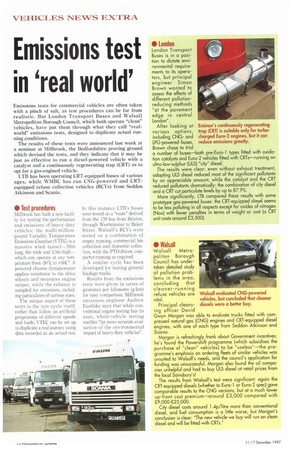Emissions test in 'real world'
Page 16

If you've noticed an error in this article please click here to report it so we can fix it.
Emissions tests for commercial vehicles are often taken with a pinch of salt, as test procedures can be far from realistic. But London Transport Buses and Walsall Metropolitan Borough Council, which both operate "clean" vehicles, have put them through what they call "realworld" emissions tests, designed to duplicate actual running conditions.
The results of these tests were announced last week at a seminar at Millbrook, the Bedfordshire proving ground which devised the tests, and they indicate that it may be just as effective to run a diesel-powered vehicle with a catalyst and a continuously regenerating trap (CRT) as to opt for a gas-engined vehicle.
LTB has been operating CRT-equipped buses of various ages. while WMBC has run CNG-powered and CRTequipped refuse collection vehicles (RCVs) from Seddon Atkinson and Scania.
• Test procedures In this instance LTB's buses
Millbrook has built a new faciliwere tested on a "route" derived ty for testing the performance from the 159 bus from Brixton, and emissions of heavy-duty through Westminster to Baker vehicles: the multi-millionStreet. Walsall's RCVs were pound Variable Temperature tested on a combination of Emissions Chamber (VTEC) is a empty running, commercial bin massive wind tunnel-26m collection and domestic collec long, 6m wide and 5.5m high tion, with the PTO-driven com which can operate at any tempactor running as required.
perature from -30°C to +50C°. A A similar cycle has been powered chassis dynamometer developed for testing general applies resistance to the drive haulage trucks.
wheels and measures engine Results from the emissions output, while the exhaust is tests were given in terms of sampled for emissions, includgrammes per kilometre (g/km) ing particulates of various sizes. for easy comparison. Millbrook The unique aspect of these emissions engineer Andrew tests is the test cycle itself: Eastlake says that while con rather than follow an artificial ventional engine testing has its programme of different speeds uses, whole-vehicle testing and loads, VI:EC can be set up enables "far more accurate eval to duplicate a real journey using uation of the environmental data recorded in an actual run. impact of heavy-duty vehicles".
• London
London Transport Buses is in a position to dictate environmental requirements to its operators, but principal engineer Simon Brown wanted to assess the effects of different pollutionreducing methods "at the pavement edge in central London".
After looking at Eminox's continuously regenerating various options, trap (CRT) is suitable only for turboincluding CNGand charged Euro-2 engines, but it can LPG-powered buses, reduce emissions greatly. Brown chose to trial a number of buses—both pre-Euro-1 types fitted with oxidation catalysts and Euro-2 vehicles fitted with CRTs—running on ultra-low-sulphur (ULS) "city" diesel.
The results were clear: even without exhaust treatment, adopting ULS diesel reduced most of the significant pollutants by an appreciable amount, while the catalyst and the CRT reduced pollutants dramatically: the combination of city diesel and ci CRT cut particulate levels by up to 87.9%. More significantly, LTB compared these results with some prototype gas-powered buses: the CRT-equipped diesel seems to be less polluting in all respects except for oxides of nitrogen (Nox) with fewer penalties in terms of weight or cost (a CRT unit costs around £3,500).
• Walsall
Walsall Metro politan Borough Council has under taken detailed study of pollution prob lems in the area, concluding that cleaner-running refuse vehicles are vital.
Principal cleansing officer David Gwyn Morgan was able to evaluate trucks fitted with compressed natural gas (CNG) engines and CRT-equipped diesel engines, with one of each type From Seddon Atkinson and Scania.
Morgan is refreshingly frank about Government incentives: he's found the Powershift programme (which subsidises the purchase of "clean" vehicles) to be "useless"—the programme's emphasis on ordering Fleets of similar vehicles was unsuited to Walsall's needs, and the council's application For funding was unsuccessful. Morgan also found the oil companies unhelpful and had to buy ULS diesel at retail prices from the local Sainsbury's! The results from Walsall's test were significant: again the CRT-equipped diesels (whether to Euro-1 or Euro-2 spec) gave comparable results to the CNG versions, but at a much lower up-Front cost premium—around 23,000 compared with £9,000-£25,000.
City diesel costs around 1.4p/litre more than conventional diesel, and fuel consumption is a little worse, but Morgan's conclusion is clear: "The new vehicle we buy will run on clean diesel and will be fitted with CRTs."
















































































































